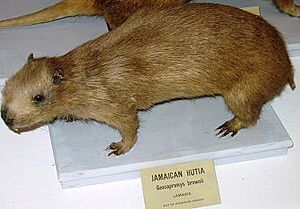Jamaican coney facts for kids
Quick facts for kids Jamaican coney |
|
|---|---|
 |
|
| Conservation status | |
| Scientific classification | |
| Genus: |
Geocapromys
|
| Species: |
brownii
|
The Jamaican coney (Geocapromys brownii) is a small, rat-like animal. It is also known as the Jamaican hutia or Brown's hutia. This animal is only found on the island of Jamaica. It is about the size of a rabbit.
Jamaican coneys live in group nests and are active at night. They eat fruits, bark, and other plants. This animal is currently endangered. This means there are not many left. They are in danger because their homes are being destroyed. They are also hunted, and new animals brought to Jamaica can harm them. Today, they only live in remote mountain areas. The Jamaican coney is a type of Hutia. It is the only native mammal left in Jamaica, besides bats.
Contents
What is a Jamaican Coney?
The Jamaican coney is usually about the size of a cottontail rabbit. Adult coneys typically weigh between 1 and 2 kilograms (about 2 to 4 pounds). They are reddish-brown or yellowish-brown in color. Their body length ranges from about 330 to 445 millimeters (13 to 17.5 inches).
They have the shortest tail of all animals in their group, about 45 millimeters (1.8 inches) long. Jamaican coneys have a large head, short legs, and short ears and neck. They also have strong front teeth called incisors. Their cheek teeth are also very strong.
Where Do Jamaican Coneys Live?
Jamaican coneys live only in Jamaica. They are mostly found in remote and mountainous areas. People have seen them in the Blue and John Crow Mountains National Park. This park is in the eastern part of the island. They also live in the St. Thomas Parishes.
In the west, they have been found in Harris Savannah. They also live in the Brazilletto Mountains in Clarendon Parish, Jamaica.
How Do Jamaican Coneys Behave?
Jamaican hutias are mostly active at night. This means they are nocturnal. They search for food when it is dark. They eat many different things. This includes fruits, exposed roots, and bark. They also eat the leaves from many types of plants. The IUCN has listed them as an endangered species.
Scientists have watched Jamaican hutias that live in captivity. These animals do not build their own nests. They have strong social connections with their family members. They groom each other and play together. They also make soft sounds when they are not touching. They can stand partly on their feet. They are also very good at climbing and jumping. They often use their front teeth to help them grip things.
Reproduction and Life Cycle
Not much is known about how Jamaican hutias reproduce in the wild. However, observations from animals in captivity show some facts. Female hutias become adults and can have babies at about one year old. Males usually become adults a bit later.
Females typically have two litters of babies each year. Each litter usually has about two young ones. The mother carries the babies for about 123 days before they are born. The young are born very developed. They can walk right after birth. They can also eat adult foods within about 30 hours of being born.


